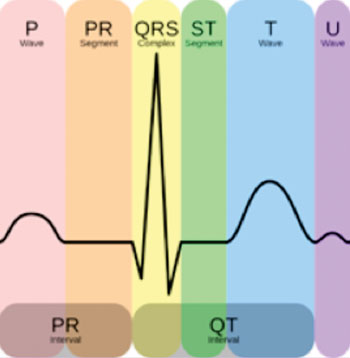Area of Noncoding DNA Regulates Activity of Heartbeat Control Protein
By LabMedica International staff writers
Posted on 10 Jun 2014
Variants in a stretch of DNA not used by the genome for coding proteins have been linked to changes in the way the heart beats and may be linked to the risk of sudden cardiac death.Posted on 10 Jun 2014
In cardiology, the QT interval is a measure of the time between the start of the Q wave and the end of the T wave in the heart's electrical cycle. The QT interval represents electrical depolarization and repolarization of the ventricles. A lengthened QT interval is a marker for the potential of ventricular tachyarrhythmias and a risk factor for sudden death.

Image: Normal ECG/EKG complex with labels (Photo courtesy of Wikimedia Commons).
Previous studies have associated the gene NOS1AP (nitric oxide synthase 1 adaptor protein) and NOS1AP polymorphisms with the QT interval length. Investigators at Johns Hopkins University (Baltimore, MD, USA) continued research in this area by employing multiple human genetic and molecular genetic assays as well as cellular assays using genetically engineered rat cardiomyocytes to look at the relationship between gene expression and QT interval length.
They reported in the May 22, 2014, online edition of the American Journal of Human Genetics that they were able to identify a functional variant underlying trait association: a noncoding polymorphism that mapped within an enhancer of NOS1AP and affected cardiac function by increasing NOS1AP transcript expression. They further localized NOS1AP to cardiomyocyte intercalated discs (IDs) and demonstrated that overexpression of NOS1AP in cardiomyocytes led to altered cellular electrophysiology.
“Traditionally, geneticists have studied gene variants that cause disease by producing an abnormal protein,” said senior author Dr. Aravinda Chakravarti, professor of medicine, pediatrics, molecular biology, genetics, and biostatistics at the Johns Hopkins University. “We think there will turn out to be many DNA variants that, like this one, cause disease by making too much or too little of a normal protein. The problem is that most of these variants lie outside of genes, in the noncoding DNA that controls how genes are used, so it is hard to tell what genes they are affecting.”
“Hundreds of genome-wide association studies have been done to find genetic variants associated with disease, but this is one of just a handful of follow-up studies to look for the mechanism behind such a variant,” said Dr. Chakravarti. “I think we have shown there is great value in asking why.”
Related Links:
Johns Hopkins University




 assay.jpg)



 Analyzer.jpg)






